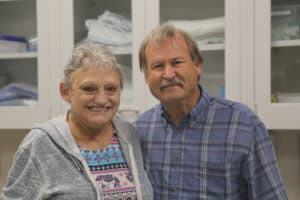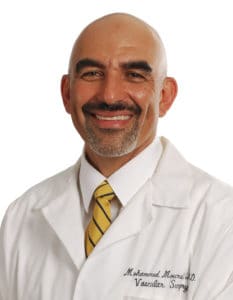Second Opinion Leads to Life-Saving Vascular Surgery
| Sandra Harvey of Watts, Oklahoma, loves to cook for her husband and their seven grandchildren. She also loves to magnet fish, which is using a strong magnet to try and grab metal objects that are hidden or lost underwater.
After a grim diagnosis in August from a Northwest Arkansas physician, she wasn’t sure whether she would ever do either of these things again. But a second opinion and then surgery from a UAMS physician restored her hope for the future.
She first visited her doctor because of symptoms of severe almost constant dizziness and fatigue. She was diagnosed with global brain ischemia, a condition that occurs when the brain is not getting enough blood due to narrowed vessels. Her doctor told her there was nothing more they could do and that she just had to live like this and that her condition would deteriorate and she could eventually die from this.
“It was hard to come out and look at my husband and tell him what the doctor said,” Harvey said. “Telling my mom was one of the hardest things I’ve ever done.”
After that, her first phone call was to one of her sisters, DJ Greenlee, who lives in Little Rock and works as a nurse at the John L. McClellan Memorial Veterans’ Hospital. Greenlee worked closely with UAMS Chief of Vascular Surgery Mohammed Moursi, M.D. who also sees patients at the VA.
“She said we should get a second opinion. And we did,” Harvey said. “She picked a very fine doctor for me. He always has a big smile on his face. He told me everything was going to be okay and it was.”
Moursi, who is board certified and fellowship trained in vascular surgery, carefully examined the x-ray images of her blood vessels and recognized there were treatment options.
“There are four major blood vessels that supply the brain, two carotid arteries in the front of the neck and two vertebral arteries in the back,” Moursi said. “The problem that usually happens with carotid arteries is that you get plaque inside the arteries. Once it accumulates, some of the blockage can get loose and go into the brain causing a stroke. Ms. Harvey had narrowing in all four of her arteries causing the low blood flow to the brain which made her feel weak and lightheaded.”
Moursi did two surgeries to restore proper blood flow.
For the first procedure, he guided a metal-mesh tube called a stent into her subclavian artery, which supplies one of her vertebral arteries. This stent held the artery open and restored blood flow to one of her vertebral arteries.
The second, more complicated surgery to the open the other three vessels was called an arch reconstruction, which was performed via a sternotomy.
“We had to open her chest and bypass from the aorta to all the other blood vessels going up to her brain,” Moursi said.
It’s been a few months since her surgery. Sandra Harvey says she’s grateful her husband, Larry, has been taking good care of her at home. He was with her at their October follow-up appointment with Moursi.
“How are we feeling?” Moursi says as he enters the Harvey’s clinic room. “Are we having dizzy spells?”
“I’ve had one dizzy spell, but that’s it. A lot better than before. And I’m alive thanks to you.”
There’s still some residual pain left from the surgery. But she’s happy to be back to living her life as normal.
While the magnet fishing will have to wait until warmer weather. Harvey says there’ll be plenty of warm meals with her children and grandchildren as she continues to heal and get stronger.
“She’s been a champ and has done really well,” Moursi said. “We’re happy that we were able to help her.”


